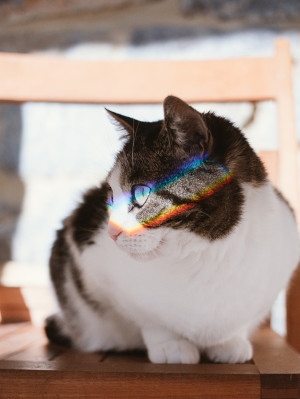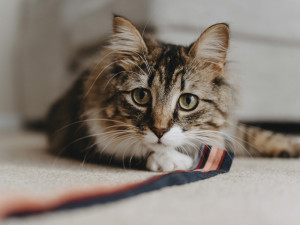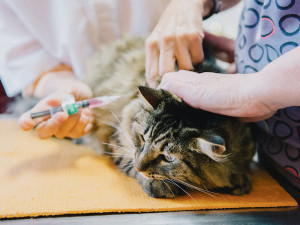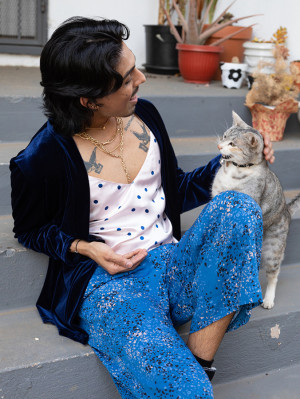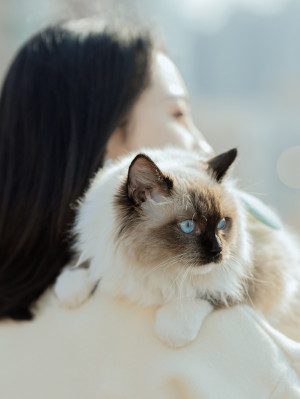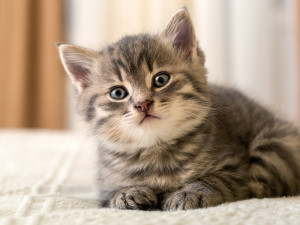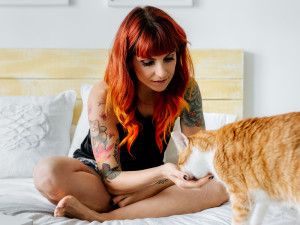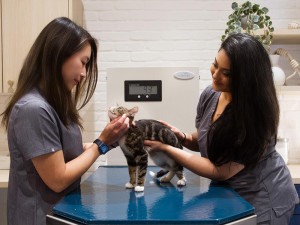Common Eye Problems in Cats and How to Treat Them
Just some things to keep an...eye on.
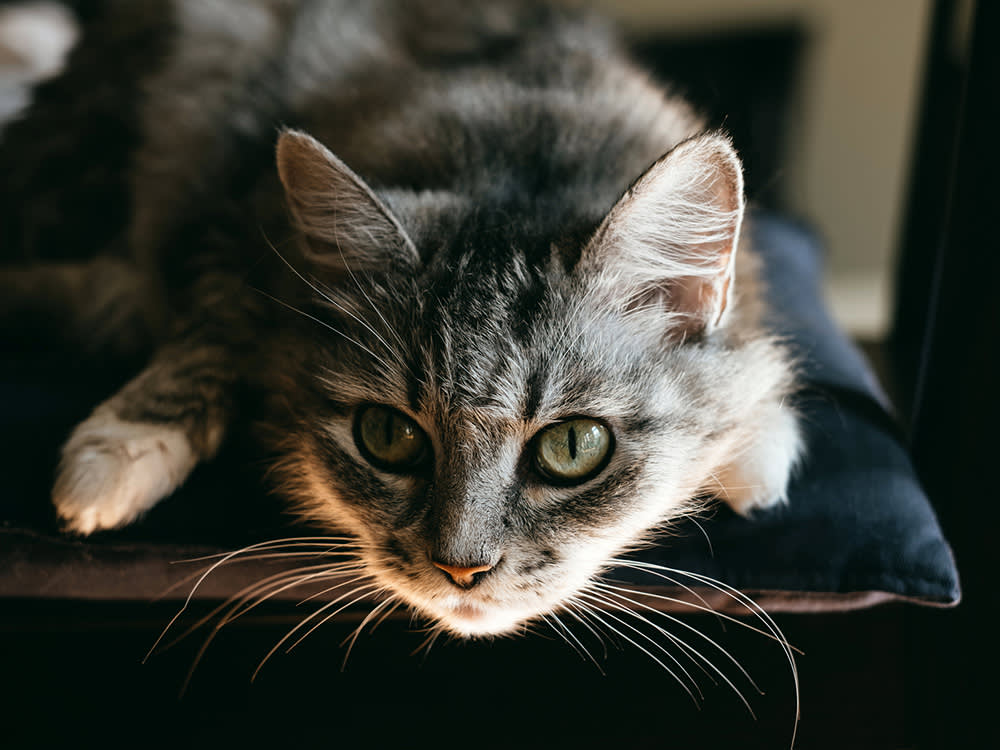
Share Article
Cats are susceptible to a variety of eye disorders, including conjunctivitis, corneal ulcers, glaucoma, cataracts, and more. Early detection and treatment are essential for the best outcome. If you notice any changes in your cat’s eyes, it is important to see a veterinarian right away for diagnosis and treatment. Treatment of eye disorders in cats will vary depending on the specific disorder and its severity.
What are the most common eye problems in cats?
Eye issues in cats can occur due to both internal and external causes. Infection, metabolic diseases, trauma, allergies, and anatomical issues can all cause eye problems for cats. While there are several diseases that can affect a cat’s eyes, some of the most common ones include:

Get (totally free) deals for food, treats, accessories, tech, and way more pet parenting must-haves.
opens in a new tabConjunctivitis (pink eye)
Corneal ulcers
Glaucoma
Cataracts
Entropion
Ectropion
Third eyelid prolapse
Retinal detachment
Uveitis
Eye infections
Eye tumors
Watery eyes
How do cats’ eyes work?
Eyes are incredibly complex structures that help cats gather information about their environment. Light enters a cat’s eye through the clear part of the surface of the eye called the “cornea.” It then passes through the anterior (front) “chamber” of the eye, which is filled with a clear fluid called the “aqueous humor.” Light then travels through the “pupil,” which is the opening in the middle of the colored “iris.” The tiny muscles of the iris widen or narrow the pupil to allow in more or less light depending on a variety of factors.
After light passes through the pupil, it enters the “lens.” The function of the lens is to focus light on the “retina,” which is the sensory surface of the eye. Light leaving the lens passes through the jelly-like “vitreous humor” before contacting the retina. The retinal surface has numerous “rods” and “cones,” which are specialized nerve cells (called photoreceptors) that are stimulated by photons of light and turn that stimulation into visual information for the brain.
Cats’ eyes have some special adaptations that evolved to help them be effective hunters. Cats are usually most active at dawn and dusk, when light levels are relatively low. To help with their low-light vision, cats developed eyes with very large corneas, the ability to open their pupils wide, and a reflective layer in the back to make the most of the light that enters their eyes. They also have more rods than cones, which allows them to see things better in low light at the cost of worse color differentiationopens in a new tab and sharpness of vision.
What are the symptoms of eye problems in cats?
Symptoms of eye disorders in cats are often obvious to observant cat parents. Cats’ large clear eyes are strikingopens in a new tab and a big part of their appearance. They’re also a big part of how cats communicateopens in a new tab with their people. Changes to those eyes are concerning and require attention. Common symptoms of eye disorders in cats include:
Discharge (especially if greenish or bloody)
A cloudy or bluish appearance to the cornea
Squinting or holding the eye closed
Pawing at the eyes
Rubbing their face on surfaces
Red coloration of the whites of the eye
Swelling or bulging of the eye
A defect (divot, scratch, etc.) on the surface of the eye
Consistently wide pupils
A change in color or appearance of the iris
Common Eye Problems in Cats
Conjunctivitis (pink eye)
The conjunctiva is the membrane that lines the inside of the eyelids and the whites of the eye. Conjunctivitis is inflammation of any part of this membrane, often making the eye appear red and swollen. Conjunctivitis is most commonly caused by a viral or bacterial infection in cats.
Corneal ulcers
A corneal ulcer describes any open wound on the cornea. Very deep ulcers can even cause a perforation of the eye and allow the fluid inside to leak out. Corneal ulcers are often caused by trauma, infections, dry eye, and irritants on the eye’s surface.
Glaucoma
Glaucoma is an increase in pressure within the eye. This can be inherited (rare in cats) or secondary to another disease affecting the eye. Glaucoma is very painful and can result in permanent blindness if not controlled quickly.
Cataracts
A cataractopens in a new tab is clouding of the lens and affects a cat’s vision by reducing the amount of light that reaches the retina. Cataracts give a whitish or milky appearance to the area just behind the pupil. Cataracts in cats are most commonly caused by chronic inflammation within the eye but may have a number of other origins.
Entropion
In some cats, the upper or lower eyelid may roll inwardopens in a new tab, allowing hair to rub on the surface of the eye. This can occur due to a herpesvirus infection, loss of fat surrounding the eye, injury, or developmental issues.
Ectropion
Ectropion is the opposite of entropion. In ectropion, the eyelid margin does not make contact with the cornea. This prevents the eyelid from doing its job of protecting the eye from drying, often resulting in a chronically dry eye.
Third eyelid prolapse (cherry eye)
The nictitating membrane (or third eyelid) is not present in humans. Cats use this extra eyelid to help keep their eyes moist and protected. There is a gland within the third eyelid that can prolapse (bulge out) and make the third eyelid remain raised, red, and inflamed.
Retinal detachment
The light-sensing tissue of the retina can separate from the back of the eye due to severely increased blood pressure, changes to the blood vessels of the eye, changes to the fluid within the eye, or injury to the lens. This markedly degrades vision and can result in permanent blindness.
Uveitis
Uveitis is inflammation of the iris, the ciliary body (which produces fluid and helps focus the lens), and the blood vessels of the eye. This can be painful and may cause the fluid in the eye to look cloudy. It can be caused by trauma, systemic infection, cancer, and many other diseases.
Eye infections
Eye infectionsopens in a new tab are usually bacterial or viral in origin, though fungal infections are also possible. Eye infections are commonly diagnosed and treated, but some can be severe and put the eye at risk if not managed quickly.
Eye tumors
Tumors can grow within the eye, most commonly causing changes to the color and shapeopens in a new tab of the iris. Tumors can also grow in the tissues of the eye socket, causing bulging or deviation of the normal eye position.
Watery eyes
Watery eyes (or “epiphora”) can result from irritants, allergens, and other diseases that affect the eye. Excessive watery discharge from the eyes is a non-specific problem, but it can indicate that work-up is needed to find the root cause.
Are certain cat breeds more prone to eye problems?
Breeds prone to eye problems in cats include brachycephalic (squish-faced) breeds and Maine Coons. A number of cat breeds have inheritable eye problemsopens in a new tab, but flat-faced breeds tend to have issues most commonly. Persian, Exotic Shorthair, British Shorthair, and Maine Coon cats all have issues with entropionopens in a new tab. Corneal sequestrationopens in a new tab, in which a piece of cornea dies off and is pushed out of the eye, is most common in Persians and Exotic Shorthairs. Burmese cats are prone to developing prolapse of the third eyelidopens in a new tab.
How are eye disorders in cats diagnosed?
The diagnosis of eye disorders in cats is made by a veterinarian or by referral to a veterinary ophthalmologist. A general physical examination is performed to evaluate overall health, then the eye is examined directly and through an ophthalmoscope, which magnifies the structures within the eye.
Depending on the cat’s symptoms, testing may be needed. Basic tests look for defects on the surface of the eye, assess appropriate tear production, and check the pressure of the eyes. More specialized tests may involve dilation of the pupil to allow better examination of the deep structures of the eye or ultrasound to look for changes to the layers of the eye.
What are the treatment options for eye disorders in cats?
The appropriate eye treatment for cats will depend on the cause of the problem. Many conditions are treated with topical medications, which can be challenging to administer to kitties. These drops or ointmentsopens in a new tab may contain antibiotics, steroids, anti-inflammatories, immunosuppressive agents, or drugs that help control the pressure within the eyes.
Cats with eye issues may also need to wear an e-collar (cone) to prevent self-trauma. Constant rubbing of the eye can worsen some problems, so a cone may be needed to protect the eye from additional damage.
Are there any home remedies?
Any eye problems in a cat should be checked out by a veterinarian to determine the cause and appropriate treatment. Do not put anything in your cat’s eyes without consulting with a veterinarian first. Many over-the-counter human eye products are not intended for use in cats and may make things worse.
Common home-care therapies involve gentle cleaning to remove discharge and debris from around the eye. For debris that is crusted on, moistening a soft washcloth with lukewarm water and holding it on the eye for a couple of minutes can help to soften dried mucus and allow it to be wiped away. This usually needs to be done before any topical eye medications prescribed by your veterinarian are administered.
What can I do to prevent eye disorders in my cat?
The best preventive measures for eye disorders in cats are based around avoiding trauma and infection. Keeping your cat indoors helps avoid fights (claws to the eye are surprisingly common and difficult to treat) and prevent infectious diseases, such as feline immunodeficiency virusopens in a new tab (FIV) and upper respiratory infections. When introducing a new housemate, keep the kitties separate until you have the all-clear from your veterinarian on feline leukemia virus (FeLV) and vaccinations.
Avoiding extra stressors for your cat can also help prevent eye disorders. Upper respiratory infections caused by feline herpesvirus can recur during times of extra stress and anxiety. It’s always hard to know what stresses a cat out, but avoiding sudden changes to their living situation can help keep them calm.
Tips to take care of a cat’s eye
Most cat parents never have to worry about their kitty’s eyes, but they still want to do everything they can to prevent problems. Some simple steps can be taken to limit problems:
Provide cats with a clean and healthy environment
Use a low-dust litter
Feed a balanced diet made for cats
Seek routine veterinary care, which includes eye examinations
Get any changes to your cat’s eyes checked out quickly
FAQs (People also ask):
Can untreated eye problems lead to blindness in cats?
Many eye issues can lead to blindness if not treated promptly and appropriately. A cat’s eyes are fairly delicate, and they only get two of them, so get any eye problems checked by a veterinarian as soon as possible.
Can I use over-the-counter eye drops for my cat’s eye problems?
Over-the-counter eye drops for your cat should only be done under a veterinarian’s guidance. OTC eye drops are made for humans, with their specific eye chemistry and pH in mind. They may cause issues for a cat if used improperly.
When should I seek immediate veterinary care for my cat’s eye problem?
Any eye issues should be checked out by a veterinarian as soon as possible because eye problems can progress quickly. Bleeding, bulging, sudden blindness, blunt trauma, and wounds are especially concerning.
References:
Hereditary and Congenital Ocular Disease in the Catopens in a new tab
Feline Entropion: a Case Series of 50 Affected Animals (2003-2008)opens in a new tab
Three Cases of Prolapse of the Nictitans Gland in Catsopens in a new tab
ECVO Manual for Presumed Inherited Eye Diseases in Dogs and Catsopens in a new tab
Clinical Approaches to Common Ocular Tumorsopens in a new tab

Dr. Bartley Harrison, DVM
Dr. Bartley Harrison, DVM is a small animal veterinarian based in North Carolina who has practiced emergency medicine since graduating from the Texas A&M College of Veterinary Medicine. His primary interest areas include pain management, cardiology, and the treatment of shock.
He is a member of the Veterinary Emergency and Critical Care Society, American Veterinary Medical Association, and American Medical Writers Association. In addition to his clinical work, he writes pet health articles to help provide accurate information for both new and experienced pet parents. When he’s not working, he enjoys cooking, traveling, reading, and going on adventures with his dog.
Related articles
![Brown Labrador lifting front leg]() opens in a new tab
opens in a new tabHow to Get a Head Start on Your Pet’s Health
Spot lumps, limps, and lethargy early on.
![Kitten sitting on a blanket]() opens in a new tab
opens in a new tab7 Steps to Keep Your New Kitten Happy and Healthy
With great cuteness comes great responsibility. A vet breaks down everything you need to know when you bring home a new kitten.
![Young modern woman with tattoos and orange hair sitting cross-legged on her bed with her cat]() opens in a new tab
opens in a new tabDoes My Cat Really Need to See a Vet?
Cats can be hard to read. Especially when they’re sick. Or…not sick? We asked a veterinarian how to tell.
![A vet and a vet tech check up on a happy grey kitten in the office]() opens in a new tab
opens in a new tabHow to Find a Vet Who Loves Your Cat Like You Do
I had to kiss a lot of frogs to find the perfect vet. Luckily, veterinarian Dr. Annette Louviere has some tips so you don’t have to, too.
![A senior cat is held in their owner's lap]() opens in a new tab
opens in a new tabHow to Care for Your Senior Cat
From taking them to the vet more often to giving them a hand with grooming, older kitties need a little extra TLC.
![A woman with tattoos hugging her white cat in a cluttered, art-filled room]() opens in a new tab
opens in a new tabCats, Priceless. Cat Parenthood, Not So Much
A rundown of the most common cat expenses.
